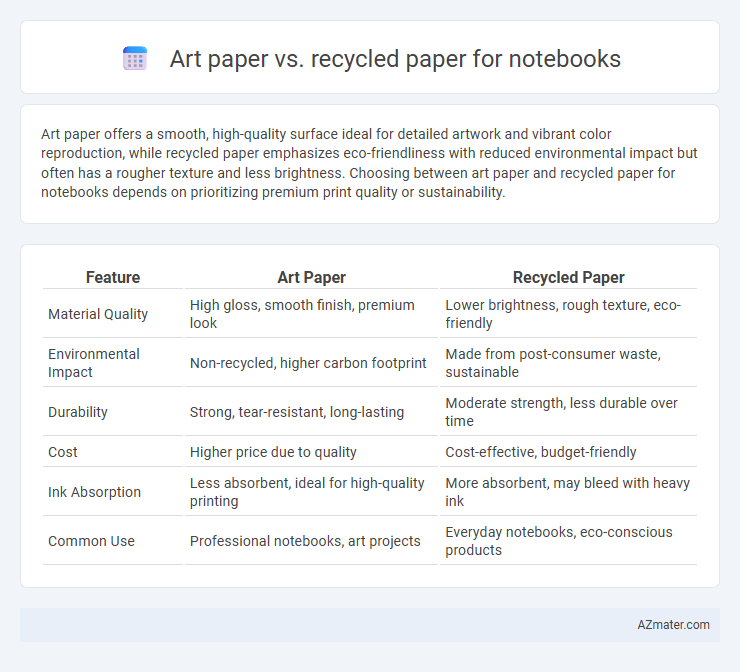Art paper offers a smooth, high-quality surface ideal for detailed artwork and vibrant color reproduction, while recycled paper emphasizes eco-friendliness with reduced environmental impact but often has a rougher texture and less brightness. Choosing between art paper and recycled paper for notebooks depends on prioritizing premium print quality or sustainability.
Table of Comparison
| Feature | Art Paper | Recycled Paper |
|---|---|---|
| Material Quality | High gloss, smooth finish, premium look | Lower brightness, rough texture, eco-friendly |
| Environmental Impact | Non-recycled, higher carbon footprint | Made from post-consumer waste, sustainable |
| Durability | Strong, tear-resistant, long-lasting | Moderate strength, less durable over time |
| Cost | Higher price due to quality | Cost-effective, budget-friendly |
| Ink Absorption | Less absorbent, ideal for high-quality printing | More absorbent, may bleed with heavy ink |
| Common Use | Professional notebooks, art projects | Everyday notebooks, eco-conscious products |
Introduction to Art Paper and Recycled Paper
Art paper is a premium, high-quality material known for its smooth texture and excellent ink absorption, making it ideal for vibrant, detailed artwork and professional-grade notebooks. Recycled paper is produced from post-consumer waste, offering an eco-friendly alternative with a focus on sustainability, though it may have a rougher texture and lower brightness compared to art paper. Selecting between art paper and recycled paper for notebooks depends on the balance between print quality and environmental impact preferences.
Material Composition and Sources
Art paper for notebooks typically consists of high-quality cellulose fibers derived from virgin wood pulp, often enhanced with calcium carbonate and coatings for smoothness and brightness. Recycled paper is composed primarily of post-consumer and post-industrial fibers, sourced from used paper products that undergo deinking and reprocessing to reduce environmental impact. The material composition of recycled paper generally results in a lower brightness and different texture compared to art paper, with both types varying in sustainability based on sourcing and processing methods.
Surface Texture and Finish
Art paper offers a smooth, high-quality surface texture that enhances vibrancy and detail in printed notebooks, making it ideal for showcasing intricate designs and vivid colors. Recycled paper typically has a rougher, more fibrous texture, which provides a natural, rustic finish but may result in less sharp print quality. The finish of art paper is often glossy or satin, improving color contrast and durability, whereas recycled paper usually features a matte finish that emphasizes eco-friendliness and tactile warmth.
Writing and Drawing Experience
Art paper offers a smooth surface with high opacity and excellent ink absorption, making it ideal for detailed drawing and vibrant color application in notebooks. Recycled paper often has a rougher texture and lower brightness, which can cause ink to feather or bleed, impacting the clarity of handwritten notes and sketches. Choosing art paper enhances precision and color vibrancy for artists and writers, while recycled paper provides an eco-friendly option with a more tactile, authentic writing experience.
Print Quality and Color Vibrancy
Art paper offers superior print quality and color vibrancy for notebooks due to its smooth, coated surface that enhances ink absorption and sharpness. Recycled paper typically has a rougher texture and less uniform composition, resulting in muted colors and less precise prints. Choosing art paper ensures crisp images and vivid hues, ideal for notebooks featuring detailed graphics or vibrant designs.
Durability and Lifespan
Art paper offers superior durability and a longer lifespan for notebooks due to its high-quality coating and denser fiber composition, which resist wear and tear over time. Recycled paper, while environmentally friendly, typically exhibits lower durability and may yellow or degrade faster with frequent handling. Choosing art paper enhances longevity and maintains the notebook's aesthetic appeal through prolonged use.
Environmental Impact and Sustainability
Art paper typically requires higher energy and water consumption during production, resulting in a larger carbon footprint compared to recycled paper. Recycled paper reduces waste by reusing fibers, conserving natural resources, and lowering greenhouse gas emissions associated with deforestation and pulp processing. Choosing recycled paper for notebooks supports sustainable forestry practices and promotes circular economy principles, significantly decreasing environmental impact.
Cost Comparison
Art paper typically costs 20% to 40% more than recycled paper due to higher quality materials and finish. Recycled paper offers significant savings while supporting environmental sustainability, making it a budget-friendly choice for notebooks. Choices depend on balancing cost with durability and aesthetic preferences.
Best Uses for Each Paper Type
Art paper is ideal for notebooks requiring smooth surfaces for high-quality printing, vibrant colors, and detailed illustrations, making it perfect for sketchbooks and professional presentations. Recycled paper suits eco-conscious users seeking sustainable, budget-friendly options for everyday note-taking, journaling, and school use. Both paper types offer distinct benefits, with art paper focusing on visual appeal and recycled paper emphasizing environmental impact.
How to Choose the Right Paper for Your Notebook
Choosing the right paper for your notebook depends on your intended use and environmental preferences. Art paper offers a smooth, high-quality surface ideal for detailed drawing or writing, enhancing ink vibrancy and preventing bleed-through. Recycled paper appeals to eco-conscious users by reducing environmental impact while providing a slightly textured feel suitable for everyday note-taking and general writing tasks.

Infographic: Art paper vs Recycled paper for Notebook
 azmater.com
azmater.com